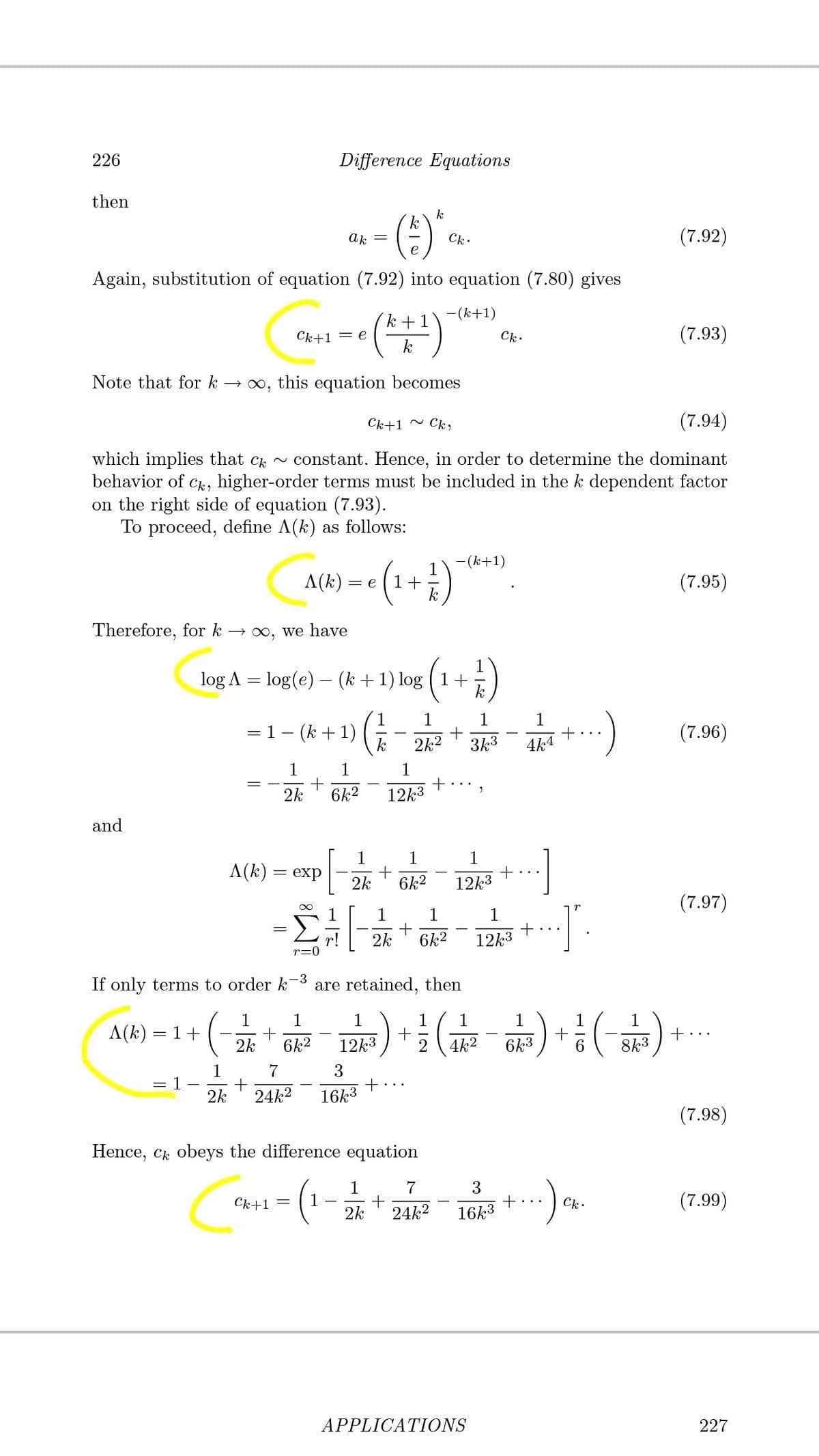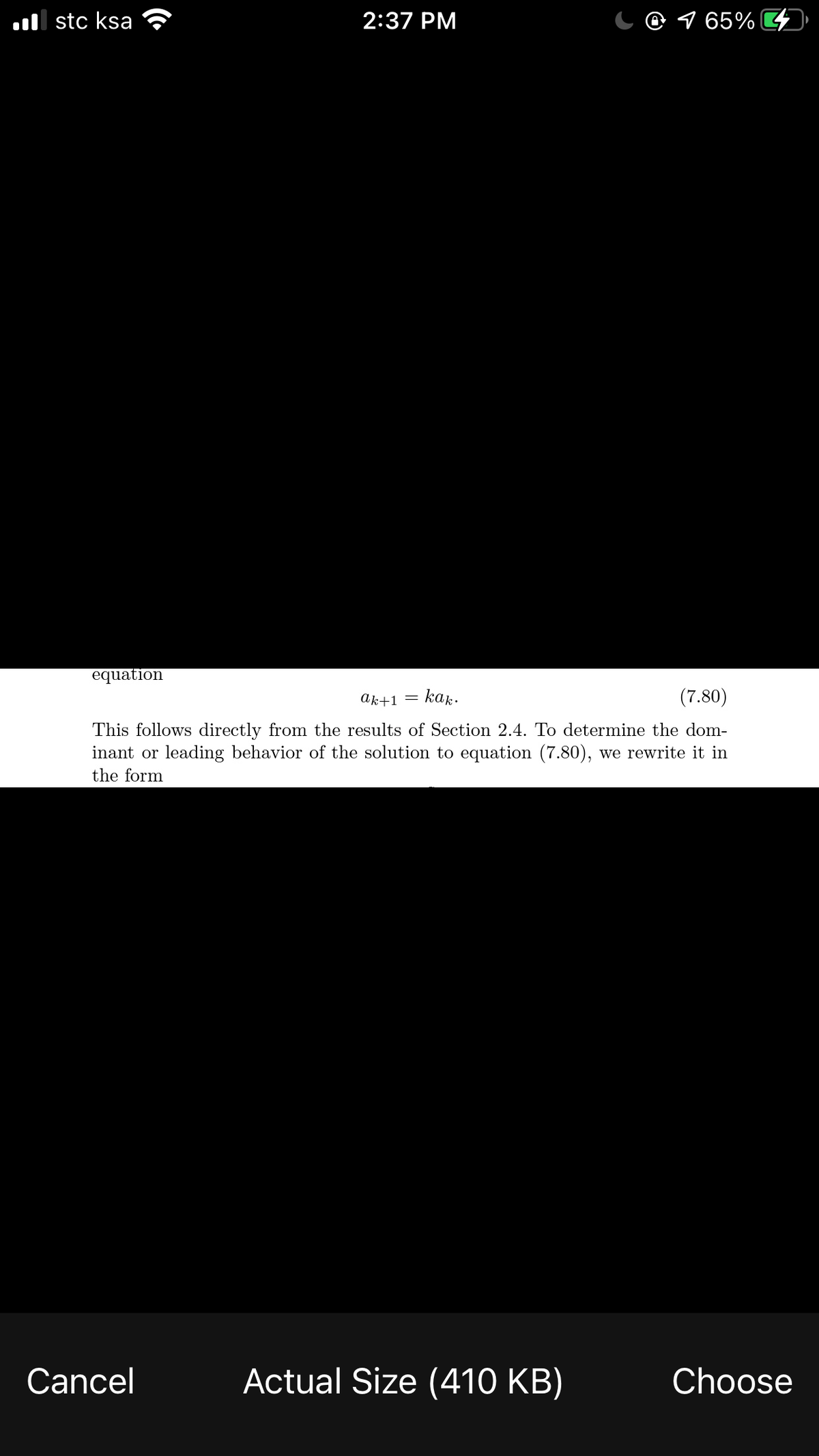(7) k +1\-(k+1) Ck. Ck+1 = e (7.93) Note that for k → 0, this equation becomes Ck+1 ~ Ck, (7.94) which implies that Ch ~ constant. Hence, in order to determine the dominant behavior of c, higher-order terms must be included in the k dependent factor on the right side of equation (7.93). To proceed, define A(k) as follows: -(k+1) Aa) - (1+) = e (7.95) Therefore, for k o, we have log A = log(e) – (k +1) log ( 1+ %3D k 1 1 1 – (k +1) ( (7.96) = 1 - k 2k2 3k3 4k4 1 1 1 2k 6k2 12k3 and 1 1 1 A(k) = exp 2k 6k2 12k3 (7.97) 1 1 2k 6k2 12k3 If only terms to order k-3 are retained, then 1 1 1 1 1 1 1 A(k) = 1+ +.. 2k 6k2 12k3 4k2 6k3 8k3 1 3 +.. 1- + 2k 24k2 16k3 (7.98) Hence, Cr obeys the difference equation (1 1 7 3 +... (7.99) Ck+1 = Ck. 2k 24k2 16k3
(7) k +1\-(k+1) Ck. Ck+1 = e (7.93) Note that for k → 0, this equation becomes Ck+1 ~ Ck, (7.94) which implies that Ch ~ constant. Hence, in order to determine the dominant behavior of c, higher-order terms must be included in the k dependent factor on the right side of equation (7.93). To proceed, define A(k) as follows: -(k+1) Aa) - (1+) = e (7.95) Therefore, for k o, we have log A = log(e) – (k +1) log ( 1+ %3D k 1 1 1 – (k +1) ( (7.96) = 1 - k 2k2 3k3 4k4 1 1 1 2k 6k2 12k3 and 1 1 1 A(k) = exp 2k 6k2 12k3 (7.97) 1 1 2k 6k2 12k3 If only terms to order k-3 are retained, then 1 1 1 1 1 1 1 A(k) = 1+ +.. 2k 6k2 12k3 4k2 6k3 8k3 1 3 +.. 1- + 2k 24k2 16k3 (7.98) Hence, Cr obeys the difference equation (1 1 7 3 +... (7.99) Ck+1 = Ck. 2k 24k2 16k3
Algebra & Trigonometry with Analytic Geometry
13th Edition
ISBN:9781133382119
Author:Swokowski
Publisher:Swokowski
Chapter4: Polynomial And Rational Functions
Section4.6: Variation
Problem 15E
Related questions
Topic Video
Question
Explain the determine yellow

Transcribed Image Text:226
Difference Equations
then
()
k
k
ak
(7.92)
e
Again, substitution of equation (7.92) into equation (7.80) gives
- (k+1)
(*)
k +1
Ck+1
Ck.
(7.93)
= e
k
Note that for k → 0, this equation becomes
Ck+1 ~ Ck,
(7.94)
which implies that c ~ constant. Hence, in order to determine the dominant
Ck, higher-order terms must be included in the k dependent factor
behavior of
on the right side of equation (7.93).
To proceed, define A(k) as follows:
-(k+1)
A(k) = e
1+
(7.95)
Therefore, for k → 0, we have
log A = log(e) – (k +1) log ( 1+
1
= 1- (k + 1)
k
1
1
1
(7.96)
2k2
3k3
4k4
1
1
1
2k
6k2
12k3
and
1
1
1
A(k)
exp
2k
6k2
12k3
(7.97)
1
1
1
2k
6k2
12k3
r=
If only terms to order k-3 are retained, then
1
+
2k
1
1
1
1
1
A(k)
1+
+..
6k2
12k3
2
4k2
6k3
8k3
1
7
1
2k
3
+...
24k2
16k3
(7.98)
Hence, Ck obeys the difference equation
:).
1
7
1
2k
(7.99)
Ck+1 =
+...
Ck•
24k2
16k3
APPLICATIONS
227

Transcribed Image Text:l stc ksa
2:37 PM
C @ 1 65% 4
equation
ak+1 =
= kak.
(7.80)
This follows directly from the results of Section 2.4. To determine the dom-
inant or leading behavior of the solution to equation (7.80), we rewrite it in
the form
Cancel
Actual Size (410 KB)
Choose
Expert Solution
This question has been solved!
Explore an expertly crafted, step-by-step solution for a thorough understanding of key concepts.
Step by step
Solved in 2 steps

Knowledge Booster
Learn more about
Need a deep-dive on the concept behind this application? Look no further. Learn more about this topic, advanced-math and related others by exploring similar questions and additional content below.Recommended textbooks for you

Algebra & Trigonometry with Analytic Geometry
Algebra
ISBN:
9781133382119
Author:
Swokowski
Publisher:
Cengage

Algebra & Trigonometry with Analytic Geometry
Algebra
ISBN:
9781133382119
Author:
Swokowski
Publisher:
Cengage